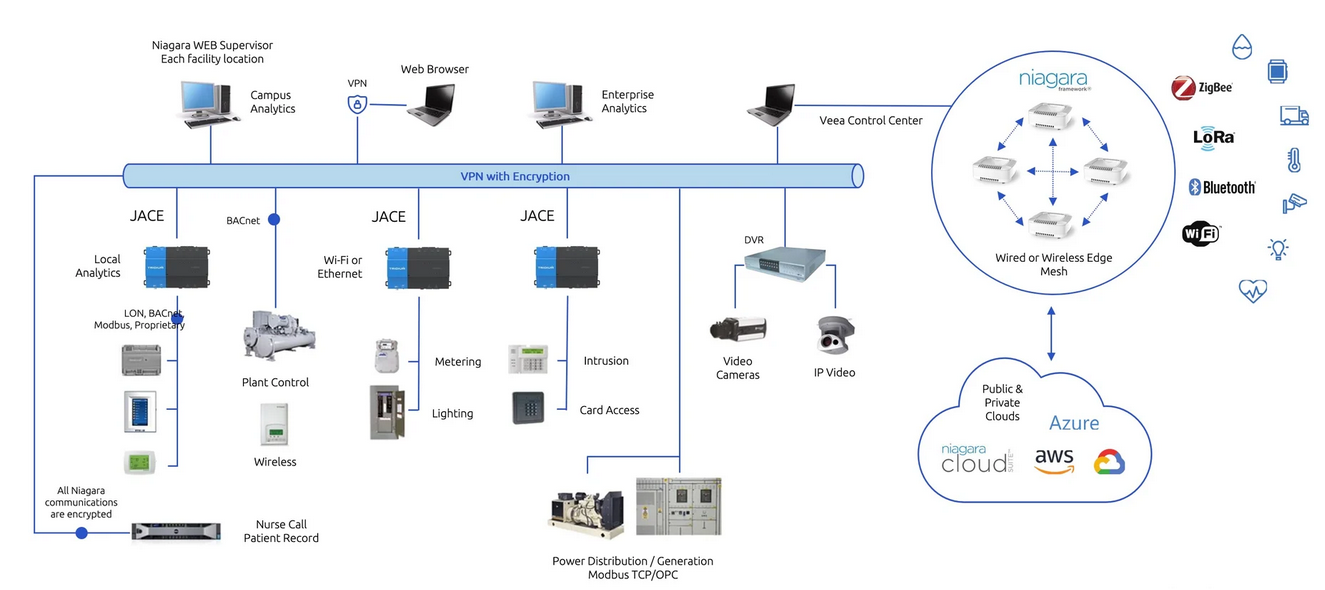Niagara Framework | Smart Building Solutions October 23, 2024
What is Containerised Tridium Niagara Framework?
Understanding Containerised Tridium Niagara Framework: Revolutionising Building Management Systems
In the realm of building management systems (BMS), efficiency, scalability, and integration are paramount. In this context, the advent of containerisation technology can significantly reshape how BMS solutions are deployed, managed, and integrated. Tridium’s Niagara Framework, a stalwart in the BMS industry, has embraced this evolution through containerisation, paving the way for enhanced flexibility, compatibility, and performance. Let’s delve into what a containerised version of Tridium’s Niagara Framework entails, its deployment possibilities, integration with existing BMS infrastructure, and the wealth of benefits it offers.
Understanding Containerisation
Containerisation is a lightweight virtualisation technology that encapsulates an application and its dependencies into a self-contained unit, known as a container. These containers provide an isolated environment, ensuring consistency across various computing environments, from development to production. Docker, a leading containerisation platform, leads the standard for container deployment, offering seamless scalability and management capabilities.
Containerised Tridium Niagara Framework
Tridium’s Niagara Framework, renowned for its open architecture and interoperability, has embraced containerisation to streamline deployment and enhance compatibility across diverse environments. A containerised version of the Niagara Framework encapsulates the entire software stack, including the framework, drivers, and applications, into portable Docker containers. The containerised Niagara deployment, is a software package, that includes everything you will need to run the application, including code, runtime environment, system tools, system libraries and settings in a virtualised environment. The supported architectures of this are ARM 64 , AMD 86X and custom support is available for different architectures.bThe authorisation models that are supported are file domain authorisation(FDA) and native domain authorisation (NDA).
This modular approach enables rapid deployment, simplified management, and seamless scaling of BMS solutions. Below is a topology example of how you can use VeeaHubs (running Containerised Niagara) to unlock data for a variety of building systems:

Deployment Possibilities
Containerised Tridium Niagara Framework offers unparalleled deployment flexibility, enabling organisations to deploy BMS solutions across a spectrum of environments, including on-premises, cloud, and edge deployments. Whether it’s a single-site building or a sprawling infrastructure spanning multiple locations, containerisation ensures consistent performance and ease of management.
Integration with Existing BMS
One of the hallmark features of the containerised Niagara Framework is its seamless integration capabilities with existing BMS infrastructure. Through standardised APIs and protocols, containerised Niagara instances can effortlessly communicate with legacy BMS systems, sensors, actuators, and IoT devices. This interoperability fosters a cohesive ecosystem where disparate systems converge, enabling centralised monitoring, control, and optimisation of building operations.
Benefits of Containerised Niagara
The adoption of containerised Tridium Niagara Framework unlocks a wealth of benefits for building owners, operators, and integrators:
Scalability: Containerisation facilitates horizontal scaling, allowing BMS solutions to effortlessly accommodate fluctuations in workload and user demand.
Portability: Containers encapsulate all dependencies, ensuring consistent behavior across different environments, from development to production.
Flexibility: Containerised Niagara instances can be rapidly provisioned, updated, and decommissioned, facilitating agile development cycles and rapid iteration.
Resource Efficiency: By optimising resource utilisation, containerisation minimises hardware overhead, reducing operational costs and maximising ROI.
Enhanced Security: Containers employ isolation mechanisms to mitigate security risks, ensuring that vulnerabilities in one container do not compromise the entire system.
Interoperability: Containerised Niagara seamlessly integrates with existing BMS infrastructure, fostering interoperability and synergy among disparate systems.
Future-Proofing: Embracing containerisation future-proofs BMS solutions, ensuring compatibility with emerging technologies and evolving industry standards.
In conclusion, the containerised version of Tridium’s Niagara Framework represents a paradigm shift in the realm of building management systems, offering unparalleled flexibility, scalability, and integration capabilities. By leveraging containerisation technology, organisations can unlock new opportunities for innovation, efficiency, and sustainability in building operations.
At One Sightsolutions, we are at the forefront of deploying containerised Niagara solutions in the UK. If you would like to discuss an upcoming project or learn more about our containerised Niagara solutions, get in touch below.
Published by Ryan – October 23, 2024




